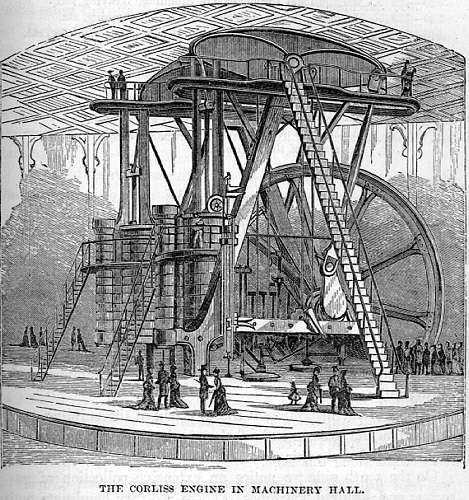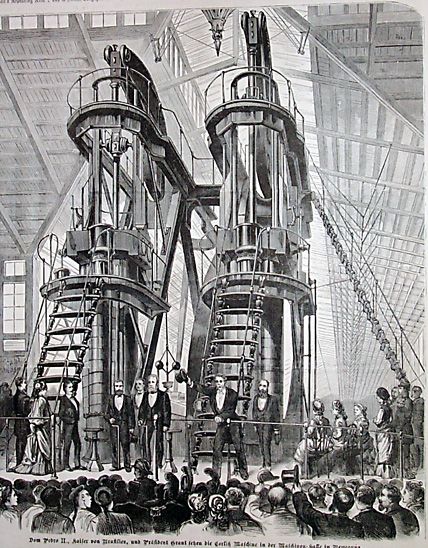

The essence here is heat energy of fuel converted into water vapor under pressure, harnessed by mechanical linkages.
Steam has a fascinating technological history, which picks up speed in the late 18th century (with mine drainage) and early 19th century (especially with railroads and steamboats) and by mid-century is just beginning to be important as a power source in manufacturing. By the end of the century steam was integral to transport and manufacturing at all levels and was beginning to be an important prime mover for electrical generation --(and it continues to be today, though it's of little direct significance for manufacturing and transport). Partly because it's less central to our own lives we take steam pretty much for granted as an energy source, which means we overlook its basics, its problematics, its implications. Here are a few points to chew over:
...which meant that the geography of manufacturing could change quite substantially and quite quickly, once effective designs for steam engines were in production
...neither flood nor drought nor freeze
...which meant that (assuming the right engineering) available power could be substantially increased, and production volume and efficiency could follow
...rail and steamboat applications opened all sorts of territory for settlement, distribution, extraction
...initially wood-fired (with all that implies for supplies and attendant industries), later coal-based (with another set of implications, still working themselves out [steam-based power generation is now about the only market for coal]
...consider the development of the metalworking skills necessary to build and maintain and improve the efficiency of steam equipment, and the advancing frontier of precision too
Before about 1860, steam was really identified with transportation, and we could spend many happy hours with boats and trains... Mark Twain's Life on the Mississippi evokes the life, and Chapter IV is especially redolent, but for the moment we'll have to skip the details of transportation, except to note the perennial problem of exploding boilers, the chief hazard of steam power, discussed at great length in many contemporary sources (there's an interesting thread that runs through Journal of the Franklin Institute, for example). But the problem of the boiler makes an interesting example of problematics:
The task of the boilermaker was to fabricate boiler shells, flues, and tubes from heavy wrought-iron plates of large dimensions with the facilities and equipment of the forge shop. These tough plates had to be cut to shape and dimension, bent, flanged, crimped, punched, or drilled. The plates had then to be brought together and riveted in order to obtain steam- and water-tight joints...Disasters of steam came from overloading (particularly true of trains and boats --cf. Mark Twain Life on the Mississippi), ineptitude of operators, poor design, ineffective safety devices, manufacturing defects, inadequate maintenance... and killed and maimed lots of people. Here's a summary of steam boiler explosions in the U.S., 1867-1879 (from Hunter 1985:368):(Louis C. Hunter A History of Industrial Power in the United States 1780-1930 vol 2 pg 310 [1985])
| Mfg and mining | Steamboats | Railroads | Total | |
| Horsepower (K) | 3109 | 986 | 5500 | 9595 |
| % total | 32.4% | 10.3% | 57.3% | |
| Boiler explosions | 928 | 186 | 185 | 1299 |
| % total | 71.4% | 14.3% | 14.2% | |
| Fatalities | 1300 | 956 | 249 | 2505 |
| % total | 51.9% | 38.2% | 9.9% | |
| avg/explosion | 1.4 | 5.1 | 1.3 | |
| Injured | 1558 | 816 | 238 | 2612 |
| % total | 59.6% | 31.2% | 9.1% | |
| avg/explosion | 1.7 | 4.4 | 1.3 |
The Golden Moment for the steam engine as a prime mover may have been at the Philadelphia Centennial Exposition of 1876, where an enormous Corliss engine was the centerpiece (and source of power) for the Machinery Hall. Contemporary illustrations glorify this "ostentatious showpiece", which was bought by Pullman after the Exposition and moved to his new factory in Illinois:


Besides the great size, the Corliss design offered dramatically greater efficiency and economy (in terms of fuel consumption) and produced a smooth flow of power, thanks to design of valves and governor.
The development of steam turbines in the late 19th century provided smooth rotary motion, with no sliding parts or vibration and a considerable gain in mechanical/thermodynamic efficiency.
If the total drop of steam-pressure was divided into many small stages, and an elemental turbine was placed at each stage, each individual turbine of the series should have an efficiency between 70 and 80%, as in a water turbine. A high efficiency should therefore result for the whole series. Furthermore, in order to reach maximum efficiency the speed of rotation necessary would be moderate, as compared with the extreme speed obtained by allowing the whole drop of pressure to take place in one stage.(History of Technology vol V pg 138)